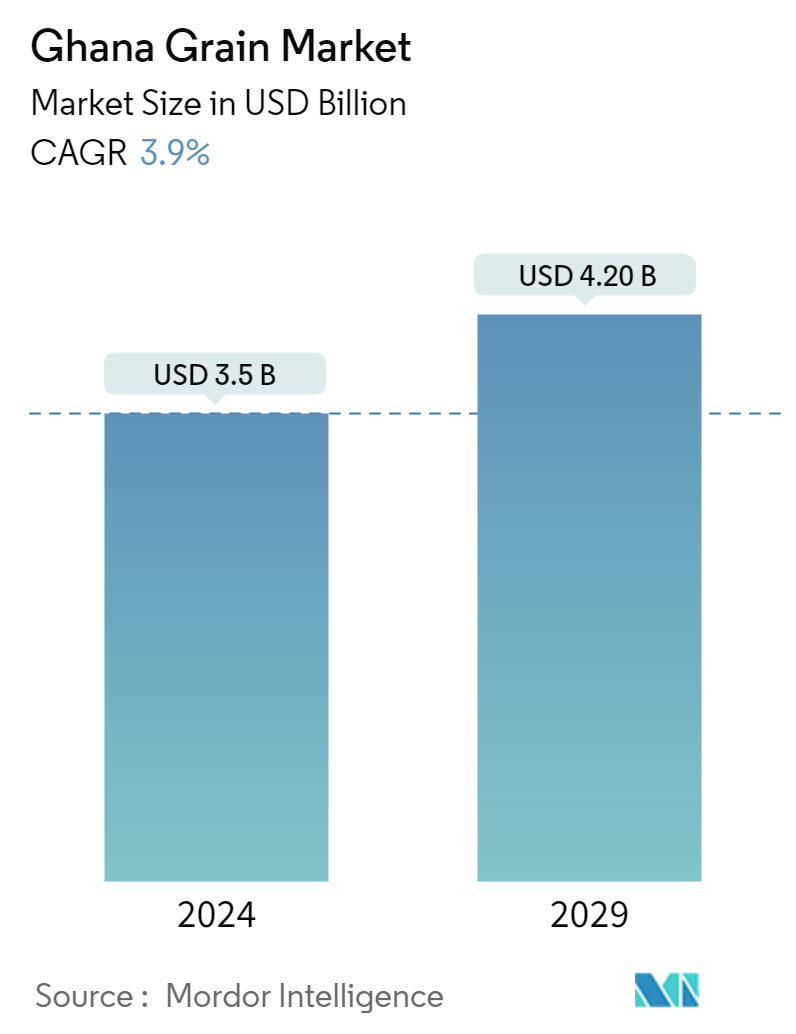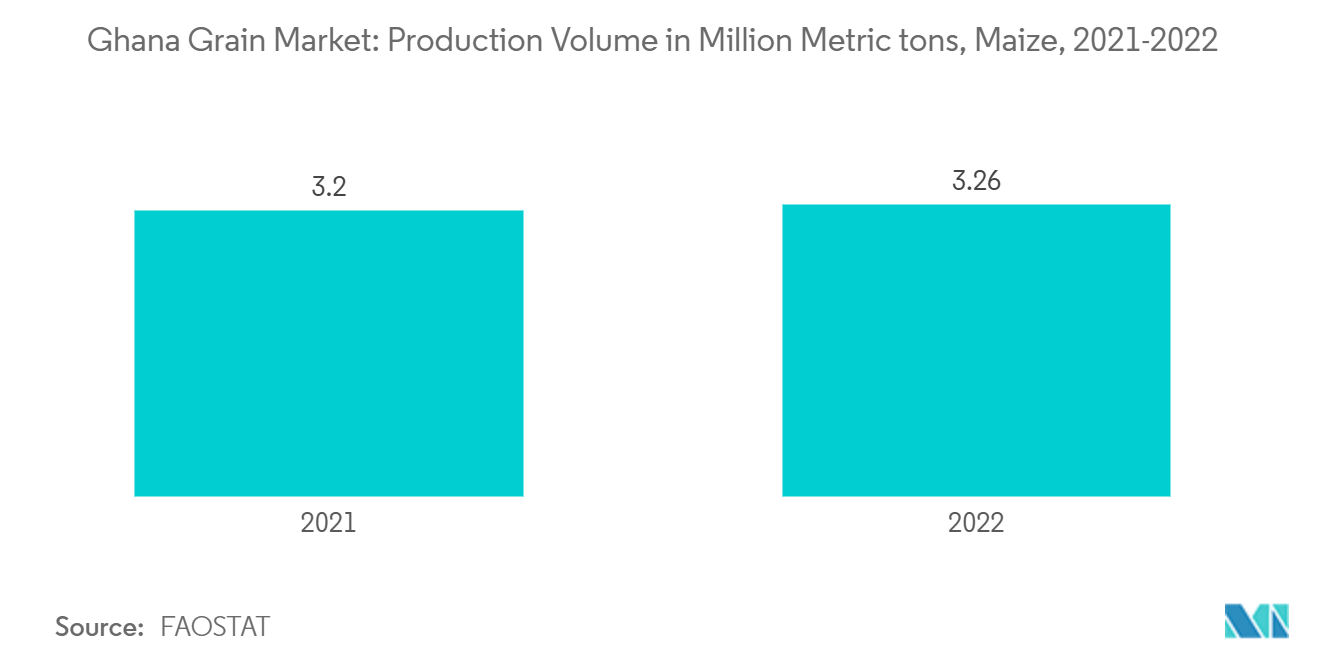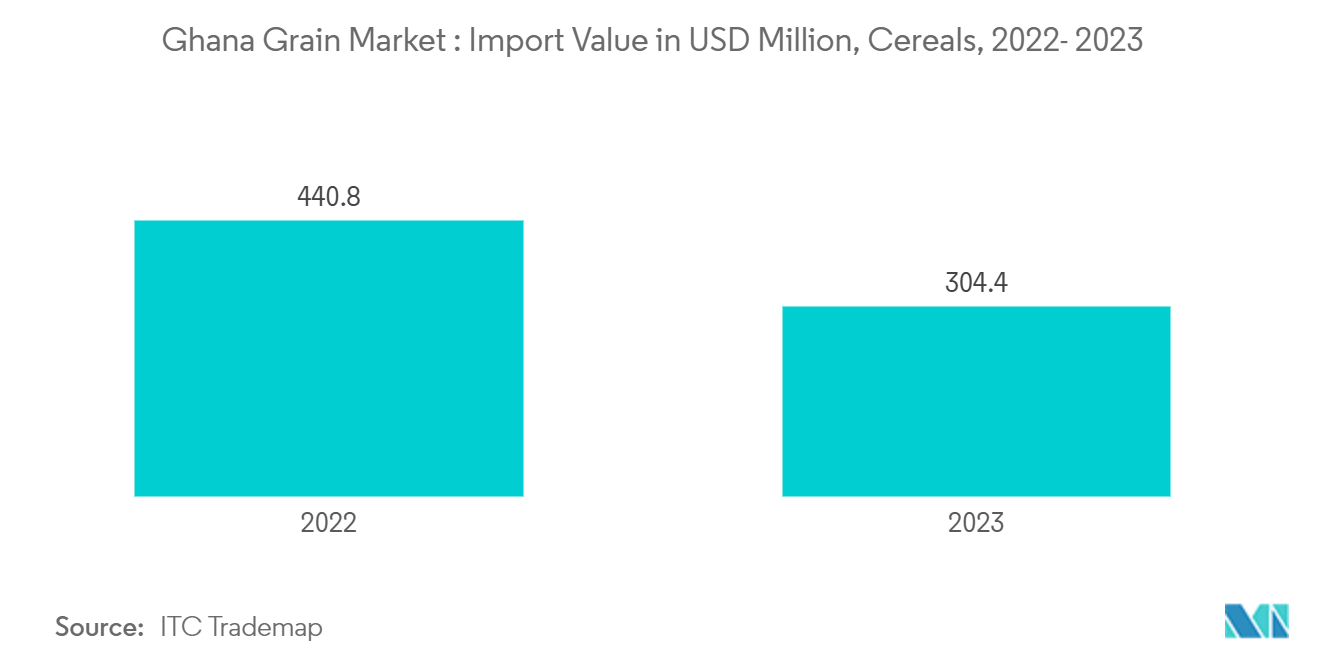Ghana Grain Market Size

| Study Period | 2019 - 2029 |
| Base Year For Estimation | 2023 |
| Forecast Data Period | 2024 - 2029 |
| Market Size (2024) | USD 3.5 Billion |
| Market Size (2029) | USD 4.20 Billion |
| CAGR (2024 - 2029) | 3.90 % |
Ghana Grain Market Analysis
The Ghana Grain Market size is estimated at USD 3.5 billion in 2024, and is expected to reach USD 4.20 billion by 2029, growing at a CAGR of 3.9% during the forecast period (2024-2029).
- The Ghanaian grain market primarily serves domestic needs, encompassing cereals, pulses, and oilseeds. Ghana relies on imports to meet its cereal demands, highlighting its lack of self-sufficiency in this sector. Locally produced cereals, notably maize and rice, play a pivotal role in traditional Ghanaian cuisine. For example, Kenkey, a staple dish made from corn dough, is widely enjoyed, often paired with pepper sauce and fried fish. Similarly, rice's growing prominence in the Ghanaian diet is attributed to its convenience and evolving tastes.
- As per FAO, maize production reached 3.3 million metric tons in 2022. Following maize, rice and sorghum were cultivated at 1,283.0 thousand metric tons and 401.5 thousand metric tons, respectively. Beans and peas dominated the pulse cultivation, while groundnut led in oilseed production. In February 2022, the Ministry of Food and Agriculture (MoFA) introduced a tech-driven initiative aimed at enhancing rice production. This project, focusing on technological advancements and quality control in post-harvest processes, aims for rice self-sufficiency by 2025.
- The expanding middle class in Ghana is shifting from traditional staples like cassava and yam to convenience foods based on rice and maize, signaling a growing market for local grain producers. Yet, challenges loom: climate change threats, insufficient financial support, and limited extension services for small-scale farmers could hinder the grain market's growth in the coming years.
Ghana Grain Market Trends
Maize Dominates the Grain Market in Ghana
In Ghana, maize stands out as the dominant cereal crop in the domestic market. Beyond its significant production volume, maize plays a crucial role in poultry feed, serves as a substitute in the brewing industry, and is cultivated using traditional methods under rain-fed conditions.
While maize is cultivated across Ghana, the primary production hubs are concentrated in the middle-southern regions, specifically Bono & Ahafo, Eastern, and Ashanti. As a staple, maize is not only widely consumed but also accounts for over a quarter of the nation's caloric intake, with local production meeting approximately three-quarters of this consumption.
Data from FAOSTAT indicates that maize production rose from 3.20 million metric tons in 2021 to 3.26 million metric tons in 2022. Maize represents 50-60% of Ghana's total cereal production. Despite its prominence, yields are hampered by the inefficiencies of traditional practices. Addressing this challenge, initiatives like the Accelerating Impacts of CGIAR Climate Research for Africa (AICCRA) have made strides. In 2022, AICCRA set up climate-smart demonstration plots in 18 communities across Central, Bono East, Upper East, Upper West, and Northern regions, promoting bundled climate-smart agriculture (CSA) technologies for maize production.

Rising Initiatives Supporting the Market Growth
The Government of Ghana has implemented structural policy changes to promote regional grain development, aiming to boost domestic production and curtail imports. The government is actively investing in crop production, providing improved inputs and introducing advanced crop production technologies to farmers. For example, in late August 2023, the Government of Ghana rolled out PFJ 2.0. The Ministry oversaw the procurement of 9,827.5 metric tons of seeds, including 5,000 metric tons of maize, 450 metric tons of rice, and 300 metric tons of sorghum. Additionally, they procured 365,165 metric tons of inorganic fertilizers and 7.2 million liters of pesticides. These were supplied to farmers for the minor planting season under the Input Credit Model. This marks a transition from an input subsidy policy to an input credit system, allowing farmers to access necessary inputs and services on credit.
In 2023, the U.S. Government, through USAID, in collaboration with the UN's World Food Programme, extended crucial support to Ghanaian farmers during the lean season. The initiative, valued at USD 7 million, aimed to bolster food security by enabling farmers to sustain agricultural activities during the lean season. This support targeted specific districts in the Upper East, Upper West, Northeast, and Northern Regions, along with neighboring areas, and spanned three months. In November 2023, the African Development Bank inaugurated a three-year research and outreach initiative in Ghana, focusing on enhancing the country's cereal value chain development. The Grain Quality Grading and Certification Project, a collaborative effort between the African Development Bank's Microeconomics, Institutional and Development Impact Division and the University of Ghana's School of Agriculture, is spearheading this initiative.
Consequently, such initiatives are poised to help Ghana gradually reduce its cereal and grain imports, bolstering the nation's food security standing. For context, data from ITC Trade Map indicates that Ghana's total cereal import value dropped from USD 440.8 million in 2022 to USD 304.4 million in 2023.

Ghana Grain Market News
- October 2022: Ghana has launched a modern maize processing facility in the Sekyere-Central District of the Ashanti Region under the 'One District, One Factory' initiative.
- April 2022: The Mastercard Foundation and IDH have introduced an initiative to transform the country's grains sector. The project, titled 'Grains for Growth', focuses on creating an inclusive and economically viable grain-supply chain. Over three and a half years, the program will collaborate with small and medium enterprises (SMEs) in northern Ghana, including off-takers and other supply chain participants. The initiative aims to generate 103,000 job opportunities within the maize, rice, millet, fonio, and sorghum supply chains.
Ghana Grain Market Report - Table of Contents
1. INTRODUCTION
1.1 Study Assumptions and Market Definition
1.2 Scope of the Study
2. RESEARCH METHODOLOGY
3. EXECUTIVE SUMMARY
4. MARKET DYNAMICS
4.1 Market Overview
4.2 Market Drivers
4.2.1 Rising Initiatives Supporting the Market Growth
4.2.2 Increased Focus on Sustainable and Green Farming
4.2.3 Opportunities Export Market
4.3 Market Restraints
4.3.1 Lack of Efficient Irrigation Facilities
4.3.2 Threat of Climate Change
5. MARKET SEGMENTATION
5.1 Crop type (Production Analysis by Volume, Consumption Analysis by Volume and Value, Import Analysis by Volume and Value, Export Analysis by Volume and Value, and Price Trend Analysis)
5.1.1 Maize
5.1.2 Millet
5.1.3 Sorghum
5.1.4 Rice
6. REGIONAL ANALYSIS
6.1 PESTLE Analysis
6.2 Value Chain Analysis
6.3 Government Policies
7. COMPETITIVE ANALYSIS
7.1 Distribution Network and Retail Analysis
7.2 List/Profile of Key Players
8. MARKET OPPORTUNITIES AND FUTURE TRENDS
Ghana Grain Industry Segmentation
Grain is the harvested seed of grasses, such as wheat, oats, rice, corn, etc. The Ghana Grain Market Report Includes Production Analysis (Volume), Consumption Analysis (Value and Volume), Export Analysis (Value and Volume), Import Analysis (Value and Volume), and Price Trend Analysis. The Market is Segmented by Crop Type (Maize, Millet, Sorghum, and Rice). The report offers market size and forecast based on value (USD) and volume (metric tons) for the above segments.
| Crop type (Production Analysis by Volume, Consumption Analysis by Volume and Value, Import Analysis by Volume and Value, Export Analysis by Volume and Value, and Price Trend Analysis) | |
| Maize | |
| Millet | |
| Sorghum | |
| Rice |
Ghana Grain Market Research Faqs
How big is the Ghana Grain Market?
The Ghana Grain Market size is expected to reach USD 3.5 billion in 2024 and grow at a CAGR of 3.9% to reach USD 4.20 billion by 2029.
What is the current Ghana Grain Market size?
In 2024, the Ghana Grain Market size is expected to reach USD 3.5 billion.
What years does this Ghana Grain Market cover, and what was the market size in 2023?
In 2023, the Ghana Grain Market size was estimated at USD 3.36 billion. The report covers the Ghana Grain Market historical market size for years: 2019, 2020, 2021, 2022 and 2023. The report also forecasts the Ghana Grain Market size for years: 2024, 2025, 2026, 2027, 2028 and 2029.
Ghana Grain Industry Report
Statistics for the 2024 Cereals in Ghana market share, size and revenue growth rate, created by ����vlog��ý™ Industry Reports. Cereals in Ghana analysis includes a market forecast outlook to 2029 and historical overview. Get a sample of this industry analysis as a free report PDF download.



